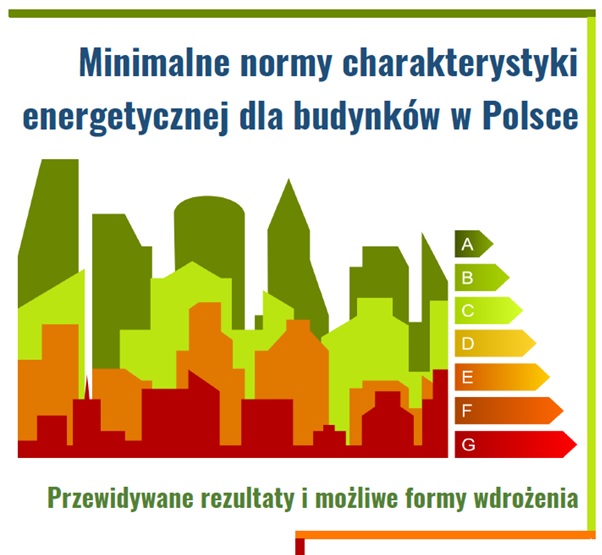MEPS in Poland: In a new report by SEENDICO, we present the results of an analysis of the impact of European energy efficiency standards for buildings on the Polish real estate market and provide key implementation recommendations.
About the Report
In the report titled “Minimum Energy Performance Standards for Buildings in Poland: Expected Results and Possible Implementation Forms,” we discuss how Poland could introduce Minimum Energy Performance Standards (MEPS) related to the planned transposition of the currently modified Directive on the Energy Performance of Buildings (EPBD).
Discussions around these anticipated European regulations prompted us to conduct a deeper analysis. In the report, we carefully examine how quickly buildings in Poland should be modernized in light of various EU proposals. Our calculations based on the proposals from the European Commission, the European Parliament, and the EU Council showed that, according to some of these proposals, the pace of modernization would be similar or even slower than what Poland has set in its own 2022 strategy (Long-Term Building Renovation Strategy). The recommended scenario in this strategy assumed annual renovation rates of 3.6% by 2030, 4.1% between 2031 and 2040, and 3.7% between 2041 and 2050. For comparison, if the EU Council’s proposal for non-residential buildings (assuming renovation of 15% of the least energy-efficient buildings by 2030 and then 10% of additional buildings with the worst energy performance by 2034) were extended to residential buildings, the renovation rate—for residential buildings alone or combined with public utility buildings—would be 2.14% annually between 2024 and 2030 and 2.5% between 2031 and 2034.
It should be noted that we did not account for certain exceptions in EU regulations or renovations not covered by the new MEPS energy standards, which slightly overestimates the effects of implementing the EPBD.
In the report, we also assessed two approaches to renovation. The first assumes an improvement in the energy efficiency of the building by only one class. The second is more ambitious and involves deeper renovations, for example, to class C. While the second scenario is more expensive (potentially costing up to 20-30% more), it yields better results in the long run. Deeper renovations allow for faster environmental benefits, such as lower energy consumption, which in practice can result in up to 40% savings on electricity bills.
SEENDICO’s Recommendations for Implementing MEPS in Poland
In addition to assessing the impact of the EPBD on Poland, we have conducted an analysis of MEPS models and present recommendations for the implementation of Minimum Energy Performance Standards and the EPBD. These recommendations encompass the following:
- Immediate Assessment of Building Resources and Introduction of Energy Classes: Conduct an immediate assessment of building resources and establish energy classes based on this assessment. Implementing an energy class system for buildings in Poland is crucial for the effective functioning of the real estate market. Participants in this market, especially buyers and tenants, should have access to information on energy efficiency as it is essential for estimating maintenance and renovation costs. Information about energy classes should be routinely provided to potential tenants or buyers. The assessment of energy efficiency and the energy class system in Poland should consider the diversity of the construction market segments. This assessment is also necessary for planning and implementing renovation support programs accompanying the EPBD implementation.
- Emphasis on Long-Term Planning and Stakeholder Communication: The introduction of MEPS should be a long-term process with well-defined modernization objectives. Key stakeholders, such as owners of buildings with the lowest energy efficiency standards targeted by MEPS or construction industry sectors, should be informed about planned building segments subject to new regulations. Attractive support programs tailored to the financial capabilities of building owners should be offered. Relevant support programs, including training systems, should be directed at businesses engaged in thermal modernization.
- Exclusion of MEPS in Ineffective Situations: Avoid the application of MEPS in situations where implementation is not cost-effective. Examples include buildings with high adaptation costs, buildings planned for demolition, or unheated and sporadically used buildings. Certainty about the introduction of new regulations (advance notice without surprises) and regulatory flexibility are key to fair treatment of property owners.
- Customized MEPS Models: Effective implementation of the EPBD requires personalized MEPS models based on the assessment of building energy efficiency. Two generic MEPS models exist: one for larger non-residential and multi-family buildings with a single owner, based on a dynamic renovation system, and another for smaller non-residential buildings, single-family homes, and multi-family buildings with multiple owners, introducing a renovation passport and comprehensive support programs tailored to owners’ economic status. Each MEPS model should offer appropriate support programs and clear communication with stakeholders.
- Financial assistance and advice: In addition to financial support, residential building owners should be provided with financial and educational tools. Support programs should include grants, loans, and tax incentives, with a focus on greater non-repayable support for owners with lower incomes. VAT refunds for building materials in residential construction could be additional support. Educational campaigns highlighting the benefits of energy efficiency are crucial. Owners should be offered tools for effective renovation, technical advice, renovation passports, and a database of qualified contractors. Collective decision-making regarding renovations in multi-family buildings may require legal support.
- Seizing Opportunities for Industry Development and Innovation: The introduction of new energy efficiency standards stimulates demand and innovation in the construction, installation, architecture, and renewable energy sectors. This opportunity should be used to support the development of industries benefiting from the modernization market. Key actions include research and development support, promoting inter-industry cooperation, raising qualifications, and supporting business development, including SMEs.
- Modification of Existing Thermal Modernization and Energy Efficiency Support Programs in Poland: Existing programs and instruments, such as “Czyste Powietrze” (Clean Air), “Fundusz Termomodernizacji i Remontów” (Thermal Modernization and Renovation Fund), “Moje Ciepło” (My Heat), thermal modernization tax relief, etc., should be modified with several key changes:
- Introduce MEPS as a qualification basis for support programs to ensure uniform standards and a focus on building modernization.
- Consider energy classes in program assessments and provide additional incentives for significant progress in this area (e.g., advancement by at least two classes).
- Prioritize support for buildings with the lowest energy efficiency standards, without excluding others.
- Adapt forms of support to individual needs and capabilities of owners, including grants, favorable loans, credit guarantees, and tax refunds, with a greater emphasis on income criteria.
- Strengthen the role of local governments in implementing MEPS through regional programs. Include advisory components in every support program to assist property owners in planning modernization investments and maximizing benefits from modernization.
These recommendations aim to facilitate the successful implementation of MEPS and the EPBD in Poland, ensuring energy-efficient building standards and promoting sustainable development in the construction sector.
Download the report (in Polish only).
The report was prepared with the support of KNAUF Insulation Sp. z o.o.




